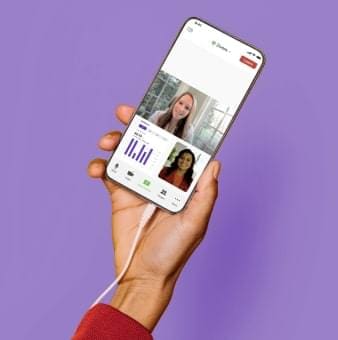Top ten insights to protect the mental health of your population

Mental health Wellbeing Workplace Engagement
The latest strategies leaders use to help their population emerge healthier, happier, and more resilient.
May is Mental Health Awareness month—leaders will need practical insights to guide their mental health strategy and help their population become more resilient. Wondr Health regularly surveys our participants to stay connected to their evolving needs. We use these insights from thousands of individuals across the globe to develop custom resources and programming to address these needs in real time. What follows are the latest insights that leaders can use to help their population emerge healthier, happier, and more resilient.
- Help your workforce connect to their values to improve health and productivity. Mental Health Awareness month is an excellent time for leaders to help individuals reconnect to their values and cultivate habits that positively impact their well-being. In a recent survey of participants, more than half of the responses indicated that participants valued family, friends, health, and well-being. Being intentional about cultivating an environment where work-life balance and time to dedicate to relationships and health are encouraged will have a positive ripple effect on the well-being and productivity of your workforce.
- Address decision fatigue through stress reduction and self-care. With recent ongoing uncertainty, the weight of making decisions with impactful consequences, and often the need to make many of the same decisions over and over again all leading to mental overload and depletion of energy and willpower. In a recent survey, 45% of participants said they experienced decision fatigue. Of those, nearly one-third pointed to uncertainty as a challenging factor associated with making decisions. Encouraging your population to take mindfulness breaks to gain clarity on what is most important and providing them with resources to manage stress and engage in self-care will help to curb decision fatigue.
- Curb stress through recognition. With increased stress and anxiety, isolation, and financial distress, employees are in need of benefits that directly address these pain points. A recent survey found that time off, instant positive feedback, and spot bonuses are needed to cope with mental health concerns, a desire for connection, and the financial stability our workforce is craving over nice-to-have perks and gifts. Consider using these insights to evolve your employee recognition program to retain top talent through the pandemic and beyond.
- Create an open dialogue to monitor workload and promote work-life balance. In a recent survey, more than one-third of participants indicated that they experience difficulty balancing time spent working versus not working or that their workload exceeds their capacity. With burnout on the rise, employers can no longer afford to ignore this issue. Building mindful leadership and communication skills among your managers will help them recognize signs of burnout in employees and create a pathway for open lines of communication around workload and mental health.
- Use gratitude as an antidote to burnout. Encouraging your population to allocate time and resources for a regular gratitude practice can help curb the effects of burnout and improve the overall health of your organization.
- Give employees permission to practice mindfulness during the day. Being intentional about dedicating time for employees to practice mindfulness during the workday will support their self-care. You can encourage employees to spend 14 minutes a day (just one percent of the day) practicing mindfulness as well as offer mindfulness workshops, and mindful meeting moment practices. This will create a culture where mindfulness is not just suggested, but actively encouraged leading to improved health and productivity for your population and a boost to your bottom line.
- Inquire about mood and sleep to assess the mental health of your workforce. The wellbeing industry has struggled to standardize a measurement for mental health. When we asked our participants how they measure it for themselves, nearly 75% reported that they gauge mental wellness through their mood and sleep. This suggests that you can ask your staff specific questions about their mood and how they are sleeping to invite a conversation on mental health and gain a better understanding of how they are doing and what support they need.
- Give your employees choice and flexibility to bring out the best in them. Our workforce is continuing to juggle work and home life amid ongoing uncertainty, disruption, and change. Having a choice in when and how often individuals work from home or the office and having the ability to work the hours they need to manage personal responsibilities were top priorities employees reported needing now in a recent survey. Employers can place their value in their people and offer flexible hours and work-from-home policies with an emphasis on productivity and connection versus hours spent working. Cultivating an environment that fosters flexibility while clearly communicating expectations and creating opportunities for colleagues to connect will help your population thrive.
- Accelerate DEI efforts and effectively communicate them to your population. While strides have been made to create more awareness, kindness, inclusive behaviors, open conversations, and dialogue around racial inequities in the workplace and community, leaders need to elevate these actions to drive policy change and influence DEI efforts at the highest level. In a recent survey, only a small percentage of participants have noticed DEI changes in policy, top-down communication, and visibility. This indicates that leaders need to take further action to communicate to their population and incorporate DEI measures into daily operations. Offering resources that complement and enhance your DEI efforts will help to drive powerful action within and beyond the walls of your organization.
- Address the whole person while building relationships at work. When we asked our participants what has helped them manage their mental and emotional health, we found that activities that were within an individual’s control ranked higher indicating that starting or restarting an exercise routine, practicing self-care, and engaging in a consistent mindfulness practice were valuable. Activities that required help from others ranked lower. Also, as the Omicron variant surges and the pandemic persists, delaying return-to-work plans, being intentional about helping your population build relationships at work and focusing on the health of the whole person will be more important than ever.
About Wondr Health
Wondr Health is the proven leader in digital behavior transformation. We partner with health plans and employers to deliver interrelated, personalized, skill-building programs for weight management, mindfulness and movement that improve the physical and emotional health of participants.





